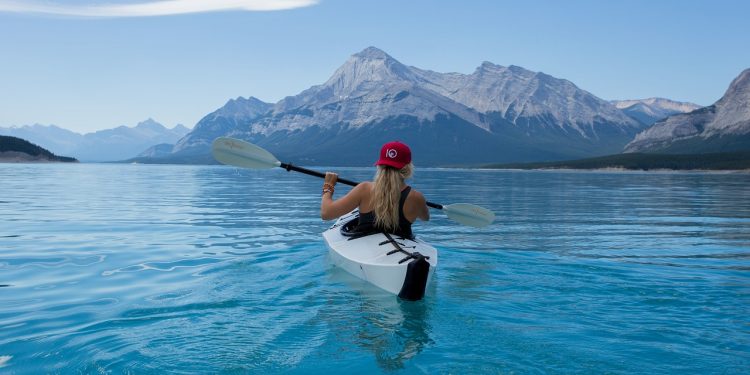Kayaking is one of the most rewarding outdoor activities, offering a peaceful escape into nature while navigating beautiful waterscapes. Solo kayaking can be an especially empowering experience, allowing you to connect with the environment on your own terms. However, it also comes with its own set of challenges and potential dangers. Staying safe while kayaking alone requires extra vigilance, planning, and respect for both your skills and the forces of nature. If you’re considering a solo kayaking adventure, here are some essential tips to help you stay safe and enjoy the ride.
1. Plan Your Route in Advance
The first step in staying safe during a solo kayaking trip is careful planning. Make sure you are familiar with your route before setting out. Choose a waterway that matches your skill level—if you’re still gaining confidence, opt for a calm lake or a slow-moving river rather than an area known for its strong currents or rapids. Study maps, charts, and any available information on the location to understand the conditions you may encounter, such as potential obstacles, water levels, or tides.
Pay close attention to the weather forecast, as changing conditions can drastically impact your trip. If there are predictions for strong winds, thunderstorms, or rapidly dropping temperatures, it is better to postpone your adventure. Knowing your route well and understanding the challenges it presents will provide you with a clear plan to follow and minimize surprises along the way.
2. Inform Someone of Your Plans
When kayaking alone, it is crucial to let someone know about your plans. Inform a friend or family member about your intended route, expected start and finish times, and any check-in points. This way, if anything goes wrong or you don’t return as scheduled, someone will know where to look or whom to alert for assistance.
In addition to telling someone, you might also consider using technology such as GPS tracking devices or a mobile app designed for outdoor activities. These tools can allow others to follow your progress and will make it easier for you to call for help if needed. Solo kayaking can be unpredictable, and having a safety net in place could make all the difference in an emergency.
3. Wear the Right Gear
Safety starts with wearing the right gear. A personal flotation device (PFD) is non-negotiable. Choose a PFD specifically designed for kayaking—these are typically less bulky, allowing for easy paddling while providing essential buoyancy. Make sure it fits properly, snugly but comfortably, and never go out on the water without it.
Dress appropriately for the water temperature, not just the air temperature. Cold water shock can occur even on a warm day, so wearing a wetsuit or drysuit in cold conditions is essential. Layer your clothing and opt for moisture-wicking and quick-drying fabrics that can keep you comfortable even if they get wet. Also, keep in mind that a wide-brimmed hat, polarized sunglasses, and sunscreen are necessary to protect yourself from sun exposure.
4. Pack Essential Safety Equipment
When you’re kayaking alone, it’s important to be self-sufficient. Bring along a whistle for signaling in case you need help—it’s a simple but effective tool that can catch the attention of others from a considerable distance. Carry a waterproof, fully charged mobile phone or a VHF radio for communication, especially if you are kayaking in more remote locations.
Also, pack a bilge pump to help you remove water from your kayak if needed, and a paddle float in case you need to re-enter your kayak from the water. A first aid kit is another must-have. Additionally, make sure you have extra drinking water and some snacks to keep your energy levels up, particularly on longer paddles. An emergency blanket can also be useful in case you find yourself unexpectedly spending longer than planned on the water.
5. Learn Self-Rescue Techniques
Being able to rescue yourself is an essential skill for any solo kayaker. Practice self-rescue techniques like the paddle float re-entry, which helps you get back into your kayak after a capsize. Knowing how to roll your kayak is also an invaluable skill, particularly in deeper or rougher waters. Enroll in a kayaking safety course if possible, as professional instruction will help you become more confident in your self-rescue abilities.
In addition to re-entry skills, learn how to balance your kayak and how to brace properly in choppy conditions. If your kayak has bulkheads, make sure they are secure and watertight. Bulkheads keep water out of your kayak’s compartments, providing you with extra buoyancy, which can be a lifesaver in a capsize situation.
6. Start Early and Avoid Paddling at Night
Daylight hours are the safest time to kayak, especially when you’re alone. Visibility is better, not only for you but for any other boaters that might be sharing the water. Starting your trip early gives you plenty of time to complete your journey before dark, minimizing the risk of getting lost or being caught out on the water in low visibility conditions.
If you must paddle close to dusk, make sure your kayak is equipped with reflective strips and lights that are visible from all directions. Attach a bright, waterproof light to yourself or your PFD. Avoiding night paddling altogether is best for solo kayakers, but having proper lighting will provide an added layer of safety if necessary.
7. Know Your Limits
One of the most important aspects of kayaking solo is understanding your limits and respecting them. Pushing beyond your skills can lead to dangerous situations, especially when no one else is around to assist. Be honest with yourself about your fitness level, paddling skill, and comfort in the conditions you’re likely to face.
Choose a route that allows you to stay within your comfort zone while still challenging yourself at a manageable level. If you encounter difficult conditions—whether strong currents, unexpected weather changes, or exhaustion—don’t hesitate to turn back. Knowing when to stop or change your plans isn’t giving up; it’s smart decision-making that ensures your safety.
8. Stay Aware of Your Surroundings
Solo kayaking requires heightened awareness of your surroundings. Always keep an eye out for changes in weather conditions, such as darkening clouds or increasing winds. Watch for potential hazards in the water, including rocks, submerged logs, or strong currents. Pay attention to other watercraft, particularly in busy areas, and try to make yourself as visible as possible.
Using your peripheral vision, regularly scan both the water and the shoreline to stay oriented and aware of any wildlife or obstacles. Listening is also crucial—being able to hear approaching boats or thunder will give you extra time to react appropriately. Remaining aware and in the moment is one of the best strategies to ensure a safe and enjoyable solo paddling experience.
9. Anchor When Necessary
If you need to take a break, whether to grab a drink of water or adjust your gear, consider using a small anchor to secure your kayak in place. This is particularly helpful in areas where there is a current, as it prevents you from drifting into hazardous locations while you’re distracted. A lightweight anchor that is easy to deploy can provide peace of mind when you need to pause.
Anchoring also allows you to relax for a few moments without constantly paddling to stay in place. It’s a great way to rest, take in the scenery, or simply enjoy a peaceful moment without worrying about where the current might carry you.
10. Trust Your Instincts
When you’re out on the water alone, your instincts are your best ally. If something doesn’t feel right, trust that feeling. Whether it’s the sense that the weather is shifting or the discomfort of an unfamiliar current, it’s better to be overly cautious than to end up in a dangerous situation.
Being alone means being completely responsible for your safety. Kayaking solo is as much a mental exercise as it is a physical one. Listen to your body and your intuition. It can mean the difference between a successful solo adventure and an experience that turns dangerous. Always trust your gut and act accordingly.
Enjoying the Solitude Safely
Kayaking alone can be an incredibly fulfilling experience, providing a chance to escape the hustle and bustle of everyday life and connect with nature. However, it also requires careful preparation and respect for the risks involved. By planning your route, informing someone of your plans, wearing the right gear, and staying aware of your surroundings, you can ensure that your solo kayaking adventure is both safe and enjoyable. Remember, the key to a successful solo trip is balancing adventure with caution—embrace the solitude while respecting the water and its unpredictability.






